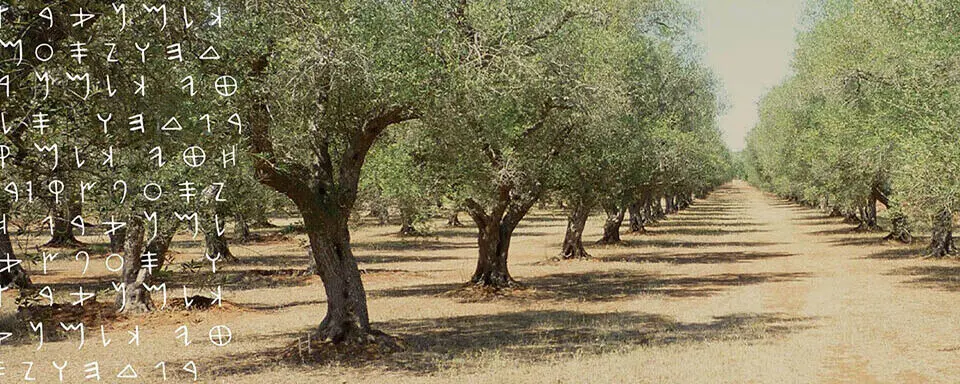Ancient Olives in Crete (Monumental Olives of Crete)
Ancient olives in Crete - The amazing age-old olives of Crete Greece
Hundreds of ancient olive trees live in Crete! According to scientists, several of these olive trees live over 1.500 years!! In 2009 cultural associations of Crete in collaboration with the Technical University TEI of Crete started an effort to record the ancient olive trees. At the same time, they informed the inhabitants of the island about the importance of these trees. They gave special information to the owners of each century-old and millennia old olive tree. The ancient olive trees continue to offer us their fruits…. still offering us their precious oil!
Ancient Olives in Crete (Monumental Olives of Crete)
In Crete, there are far many ancient olive groves with olive trees that are several centuries old – even (several) thousands years old! Some of these olive groves are protected and are part of the cultural heritage of Crete. If you want to visit ancient olive groves in Crete, you can choose from the following (they are just a few of the many monumental olive groves located all over the island of Crete, from Lassithi, Heraklion and Rethymno to Chania):
- The Memorial Olive of Kaliternas (Kali Limenes Olive Grove): This olive grove is located on the provincial road that connects Agios Pavlos with the village of Kali Limenes (Heraklion – southern Crete). The olive trees here are very old and are a local attraction.
- Kouros Olive Grove: Located near the archaeological site of Zakros (Lassithi) in the southern part of Crete. The olive grove surrounds an ancient kouros, the sculpted young man found in the area.
- The Memorial Olive of Gortyna in Messara Plain (Heraklion – southern Crete). The Messara Plain is famous for the superior quality olive oil it produces, Messara extra virgin olive oil is a PDO (Protected Denomination of Origin) olive oil.
- Memorial Olive of Azoria, is located in Lassithi, south of the village of Kavousi, near the archeological site of the same name, one kilometer south of the village, at an altitude of 252 meters. This olive tree is a natural monument and is the oldest Minoan olive tree. In fact, it is grafted onto wild rootstock, constituting the oldest sample of grafting in the world. This olive tree has been declared by the Association of Olive-Growing Municipalities of Crete as a Monument, due to the large dimensions of the trunk but also due to its location near the ancient settlements of Vrontas, Kastro and Azoria, where many vessels and olive pressing systems have been found. The olive tree belonged in 2008 to Georgios Grammatikakis and is of the Mastoid olive variety, which is locally called “muratoelia“. The maximum diameter of the trunk is 4,9 meters and the perimeter 14,20 meters. Based on the method of annual rings, the age of the tree is estimated at 3.370 years, it is estimated that it was planted between 1.350 and 1.100 BC. and is placed during the Post-Palace Minoan era (1.350 BC). In 2004, following a proposal from the residents of the area and the municipality of Ierapetra, it was decided that the first winner of the Women’s Marathon at the Athens Olympic Games, will be crowned with a wreath from this olive tree. This olive tree has been indicated as the most Ancient Minoan (and respectively 3rd after the olive tree of Naxos and the olive tree of Vouves in Chania, Crete) since it is surrounded by the nearby four ancient settlements: “Vrontos“, “Plai tou Kastro“, “Acropolis Azoria” and from the settlement of Kavousi, which dates from the year 4700 BC. with permanent residence until today. In the olive groove area itself there are Minoan ruins. Important finds of these settlements are related to the cultivation of olives during the Minoan period in the area, such as an olive press, tools, warehouses, various vessels and olive oil pits.
- Fournes Olive Grove (Memorial Olive Tree of Fournes): Located near the village of Fournes in Chania Crete. The olive grove includes many ancient olive trees and is a popular place for visitors. Visit also the Botanical Park & Gardens Of Crete which is located nearby.
- The Vouves Memorial Olive Tree in Crete (Chania) is considered the oldest olive tree in the world and is 3.000 – 5.000 years old and is still bearing fruit! This olive tree has been declared by the Association of Olive-Growing Municipalities of Crete (SEDIK) as “Monumental” due to the particularity of its shape and the excellent aesthetics of the relief of its trunk. The Vouves Memorial Olive Tree is located in Pano Vouves, D.D. Vouvon of the Municipality of Kolymvari in Chania (coordinates N 35° 29.212 and EO 23° 47.217 and altitude 272 m) and belongs to Panagiotis Karapatakis who granted it to the Municipality of Kolymvari and is of the Mastoid olive variety locally called Tsunati grafted on Agrielia rootstock. The trunk of the tree has an excellent relief with a special aesthetic. The surface of the real work of sculpture presents different shapes that imagine with strange forms of persons and things! The tree has been declared a Monument of Nature, while the first winner of the Men’s Marathon during the Athens 2004 Olympic Games was crowned with a hen from this tree, which was cut with special ceremonies. The trunk of the tree at a height of 0,9 m from the ground has a maximum diameter of 3,70 m and a perimeter of 8,10 m while at the base of the tree it has a maximum diameter of 4,53 m and a perimeter of 12,55 m. Read more about the millennial old Vouves olive tree of Crete at this international study of 6 scientists entitled “Elucidation of the Origin of the Monumental Olive Tree of Vouves in Crete, Greece“
- Memorial Olive of Palea Roumata, Chania, Crete. At the most central point of Palea Roumata in Chania is one of the designated monumental olive trees of Crete. Its age has been estimated at 3.000 years and it is one of the oldest on the island, while in the same field around it there are many other olive trees that are also centuries old and together form a unique attraction, a monument of nature. The olive is of the Mastoid olive variety that the locals call “tsunati“. Its perimeter is 10,50 meters and its trunk, which looks like a sculpture of nature, creates a huge kufala. In its hollow, the Turkish occupation, the locals had dug and placed a jar, in which they had hidden weapons, while in 1941 a committee of the villagers met inside it and decided on the resistance against the conqueror. The weapons that were used in the battle with the Germans in 1941 in Anavo Kantanos were also taken from the same kuffala.
- Vatolakkos ancient olive tree. The ancient olive Tree of Vatolakkos (Chania) is has been declared by the Association of Cretan Olive Municipalities as monumental due to its size.
- Ancient olive tree of Aerinos. The Olive tree of Aerinos has been declared monumental by the Association of Cretan Olive Municipalities, located at an altitude of 700 meters near the settlement Felesina, this ancient olive tree is impressive because of its age, its special morphology and having many stones embedded in the trunk.
- Genna ancient olive tree. Genna ancient olive tree. The monumental olive tree of Genna is at Kardamiana, near Genna (province of Amari in Rethymno Crete). Declared by the Association of Cretan Olive Municipalities as a natural monument due to shape and relief trunk.
- Fourkolia ancient tree. Fourkoulia monumental olive tree is located on the road to Piskokefalo from Sitia and has been declared a natural monument by the Association of Olive Oil Municipalities of Crete, due to its historical significance. During the turbulent and revolutionary period of Venetian rule in Crete this olive tree was used by the Venetians to hang the various Cretan revolutionaries, trying, in this violent way, to quell any revolution.
- Grambela ancient olive tree. This olive tree has been declared by the Association of Cretan Olive Municipalities as a natural monument because of shape, relief trunk and its connection with historical events. It is located at position Anisaraki, by Kantanos (Chania), where there are dozens of other ancient olive trees.
- Gre Ele ancient olive tree at Kato Tripodo. The olive tree has been declared by the Association of Cretan Olive Municipalities as a natural monument due to its size, shape and relief trunk. The name of the site is Gre Ele which means Old Olive and refers to this tree. Its variety is throumboelia and is grafted on a rootstock of a wild olive tree. It is estimated to have been planted in 650-500BC and is located very close to the archaeological site of Eleftherna.
- Amari Monumental olive grove. The Monumental olive grove of Amari is located at position Rovithis at Monastiraki, Amari Province and has been declared by the Association of Cretan Olive Municipalities as a natural monument. The several ancient trees are a dependency of the Agricultural School of Amari and unfortunately in 1980 about 1.000 more ancient trees were uprooted.
- Panasos ancient olive tree. The olive tree has been declared by the Association of Cretan Olive Municipalities as a natural monument due to its relief trunk. Its variety id called hontrelia and is grafted on a rootstock of a wild olive tree. The tree belongs to the Church and at a height of 0,8m it has 4,2m diameter and 10,6m perimeter, while its base has 4,5m diameter and 12,1m perimeter.
- Paliamas ancient Olive Tree. Paliamas Olive Tree has been declared monumental by the Association of Cretan Olive Municipalities due to its relief trunk and size. This olive tree dates back to the Sub-Minoan First Geometric period, produces big olives and it’s got a big cavity in its trunk, where three people can fit in. Its perimeter at its foot measures 20,40 meters and at a height of 80 cm from the ground it measures 10,50 meters.
- Saint George ancient olive tree at Anissaraki. The olive tree of Saint George is one of the many ancient olive trees in the areas Anisaraki and Vardaliana near Kandanos village. It has been declared as a memorial by the Association of Cretan Olive Municipalities due to its flattened shape and textured trunk.
- Samonas monumental olive tree. The olive tree has been declared by the Association of Cretan Olive Municipalities as a natural monument due to huge size and its location near the postminoan settlement of Kolydra. Its site is named Lakkos and hosts numerous ancient trees, with this specific tree being 3.000 years old.
- Mathena ancient olive tree. The olive tree of Mathena has been declared as monumental by the Association of Cretan Olive Municipalities as a natural monument due to shape and relief trunk, forming a cave with its adjacent rock.
- Kamilari ancient olive tree (Mana). The Monumental olive tree of Kamilari has been declared by the Association of Cretan Olive Municipalities as a natural monument due to its enormous size. The exact age is unknown. Most similar trees in Crete are aged around 2.000 years. But it’s a very powerful and peaceful place also worth the visit. The Monumental olive tree of Kamilari has been declared by the Association of Cretan Olive Municipalities as a natural monument due to its enormous size and its historical connection with the archeological sites of the area. The locals call this tree “Mana Elia” (Mother Olive), giving it great importance. The tree trunk has an aesthetic relief and is surrounded by 12 large stones, which were moved there by the Kamilari Cultural Association, to form a symbolic fence for its marking and protection. 8 of these stones have been carved with various symbols, such as the double ax, the symbol of the Minoans. It is located on the site Dio Lakki in the periphery of the village Kamilari in the province of Pyrgiotissa, quite close to the Kamilari Tholos Tomb (1.000m) and the Minoan Palace of Phestos (1.400m). The tree belongs to the Nikolidakis family and is a species of thrombolia, locally called “hontrolia”, grafted on a rootstock of a wild olive tree. The perimeter of the tree at the base is 9,50m and at 80cm high above the ground is 8,60m, while the diameter at the base reaches 3,25m. The age of the olive tree is estimated at 2.800 years.
- Monumental Olive Tree of Kamara at Deliana. The olive of Saint George at Kamara Deliana is aged over 2.000 years and is not the only case of monumental trees in the area. Not too far from St. George we meet a whole cluster with monumental olive trees. The picturesque village Deliana, province Kissamos, is well known for the impressive church of Saint John in the center of the village, which is one of the most important Byzantine monuments in Crete. Beyond this, in the wider area the visitor can discover some more unknown and well hidden beauties. The area is full of monuments of nature and art. At the neighborhood called Kamara we meet the old church of Saint George. It is a typical simple temple of western Crete with a simple wooden iconostasis. Next to the church there is a perennial olive tree, a real monument of nature, that even nowadays flourishes and resists abandonment. This olive tree has not been listed yet officially in the monumental olive trees of Crete and is not famous as the adjacent Monumental Olive tree in Vouves. The olive tree of Saint George at Kamara is aged over 2.000 years and is not the only case of monumental trees in the area. Not too far from Saint George there is a whole cluster with monumental olive trees, which also have not been declared as monumental.
- The Memorial Olive of Kaliternas (Kali Limenes Olive Grove): This olive grove is located on the provincial road that connects Agios Pavlos with the village of Kali Limenes (Heraklion – southern Crete). The olive trees here are very old and are a local attraction.
Greece boasts the largest percentage of olive tree coverage per land area in the world
Read more about the History of Olive Oil and olive oil cultivation on Crete
Read more about the History of the Olive Tree and Olive Oil
Ancient olives in Crete - The amazing age-old olives of Crete
A trip to the ancient olive groves of Crete. An introduction to our thousand-year-old friends who carry in their memories the entire history of Crete! (Manolis Tsantakis)
Ancient olive groves of Crete – Monumental Olive Trees
Ancient olive groves of Crete – Monumental Olive Trees
The Historical route of the olive tree
The olive (Olea Europaea) has an extremely long history, and its cultivation stretches back thousands of years. Here is a brief historical journey of the olive tree:
Prehistoric times: The olive tree is one of the first trees cultivated by humans. Archaeological findings show that olive cultivation began approximately 6.000 – 7.000 years ago in the Mediterranean region.
Ancient Greece: The ancient Greeks considered the olive tree as a symbol of wisdom and peace. They used olive oil for cooking, but also for personal care.
Ancient Rome: Olive cultivation spread throughout the Roman Empire, where olive oil was widely used in cooking and body care. The Romans developed methods of extracting and storing olive oil.
Byzantine Empire: The olive continued to be an important element in the diet and economy of the Byzantine Empire.
Medieval and Modern Times: Olive cultivation spread to other regions of the world with the European spirit of exploration. Today, the olive is grown in many regions beyond the Mediterranean, including the USA, South Africa and Australia.
The olive played an important role in the diet, economy and culture of the Mediterranean and other regions. Also, olive oil is still considered the healthiest fat and a key (along with legumes, grains and greens) in the Mediterranean diet here in particular the Cretan Diet.
The olive tree has been known since ancient times but also since prehistoric times. Historical writers state that it most likely originated in northern Syria from 4.000 BC as its mountain slopes were full of wild olives. From there the Phocaeans took it to the Greek islands and mainland Greece. Later discoveries such as that of Camps in 1974, who based on charcoal and pollen analyzes showed that there were olives in Moorish places near the shores of the Sahara desert from 12.000 BC and from there it spread to Cyprus and the coasts of North Africa (Morocco, Tunisia etc.).
In 600 BC it was carried by the Greeks to Italy, Sicily and Sardinia.
The Olive tree arrived in Spain from the Greco-Romans and the Arabs, which is why some varieties have Latin names and others Arabic names. The olive fruit as well as the oil are called aceituna and aceite respectively which are Arabic words and the tree is called olivo which is a Latin word.
The olive has a special importance in Crete, which is one of the largest producers of olive oil in Greece. Here is an overview of the importance of the olive in Crete:
Cultivation: Crete is one of the main olive growing areas in Greece. Olive groves are cultivated all over the island, from the northern part to the southern part. Cretan olive varieties have excellent quality and taste.
Olive oil production: Crete is known for the high quality of the olive oil produced. Cretan olive oil has a famous taste and aroma and is widely used in the Cretan diet and Mediterranean cuisine.
Economy: Olive oil production is an important part of Crete’s economy. Thousands of families on the island depend directly on the cultivation and collection of olives, as well as on the production of olive oil.
Tourism: Crete’s olive grove is a frequent attraction for tourists, who can visit olive mills and learn about the olive oil production process. Also, tourism focuses on gastronomy, where Cretan olive oil is an important component of the Cretan diet.
Overall, the olive tree has a strong presence in Crete, influencing the economy, culture and lifestyle of the island’s inhabitants.
In Greece the olive has been cultivated since ancient times as archaeological excavations have brought to light fossilized leaves and seeds.
- Seeds dating from the Middle Minoan era (1.800 – 2.000 BC) were found in Phaistos, Crete.
- A silver piece of vase depicting an olive tree was found in Mycenae.
- In Santorini and Nisyros, fossilized olive leaves were found that are approximately 50.000 – 60.000 years old.
- In Knossos and Thira frescoes were found on the subject of the olive tree and tools used to crush its fruit.
Lighting during the Minoan era was done with lamps that burned olive oil. The rich of the time were also distinguished from others by how much olive oil they consumed, it was a symbol of wealth, since the poorest consumed barley nuts dipped most of the times in watered wine and eating seeds of various cereals while the richest had more olive oil in their diet the and fewer seeds.
The olive tree in mainland Greece
References to the olive tree in the Christian tradition (Noah)
Some Photos of Millennial Olive Trees in Crete Greece
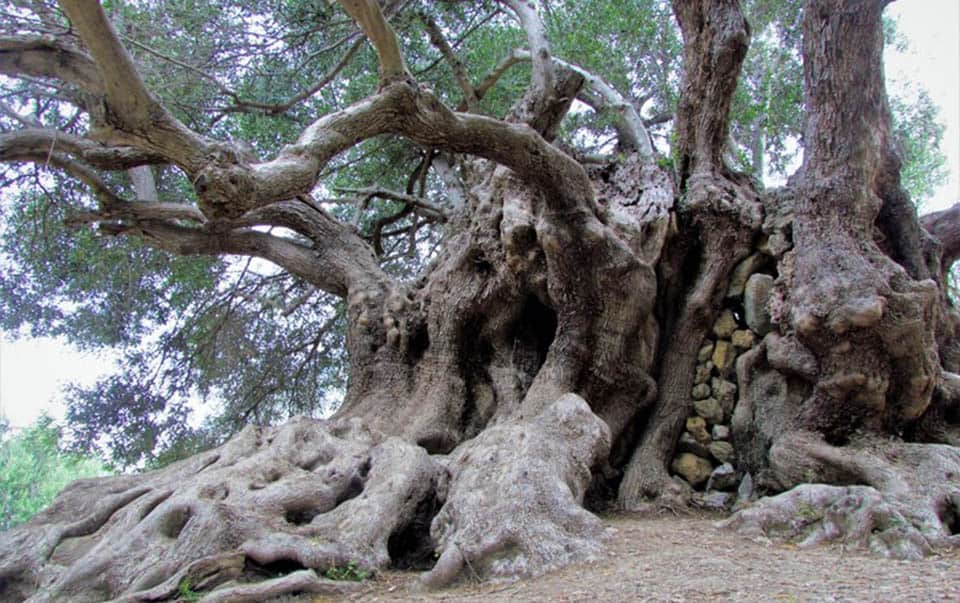
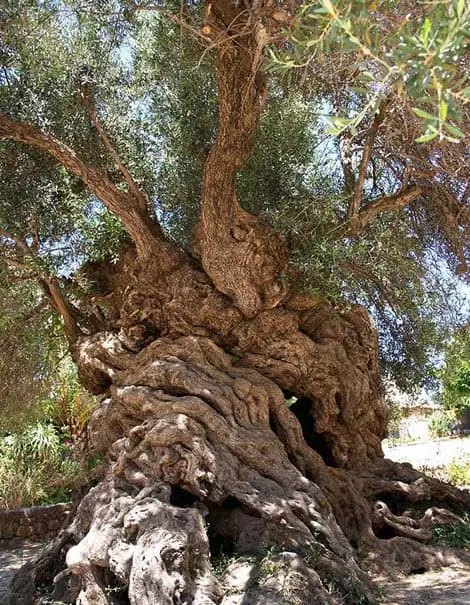

There are at least ten more monumental olive trees dating back to antiquity in and around the village of Pano Vouves in Chania, Crete. This example is believed to be about 2000 years old…
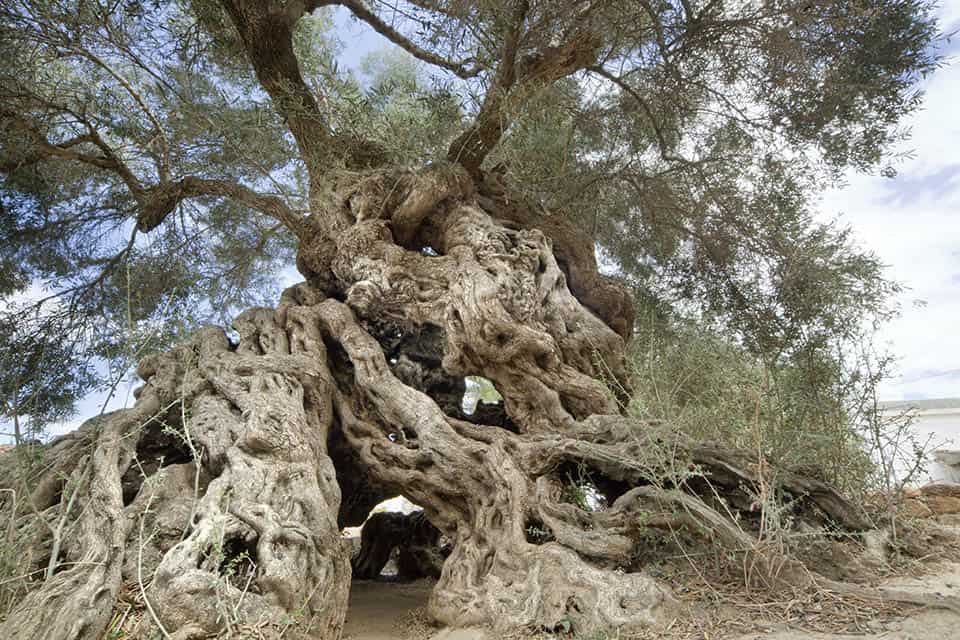
The very old olive trees on Crete that lived with the Minoans – Photo Exhibition (by Vassilis Goumas)
Registration and Promotion of Monumental Olive Trees in Greece
(Abstract and Figures)
The history of the olive tree, its cultivation and its products is known for centuries. Some olive tree have survived over millennia and their history dates back to antiquity. In many cases, it is related to mythology and religion. The olive tree is associated with folk tradition, people’s everyday life, and customs. In Greece, monumental olive trees are found in Crete, the Peloponnese, Euboea, Chios, Pelion and Attica. This paper explores and describes the particular morphological features such as shape, size, wood, cavities and age, as well as the cultural characteristics such as historical or religious events, myths and traditions that define an olive tree and characterize it as monumental. The main aim of our research is to examine the key position that monumental olive trees and their materialistic and symbolic manifestations consist a natural and cultural heritage as well. In this framework the above study focuses on various key issues related to monumental olives trees in Greece and their natural, historical, social and cultural value.
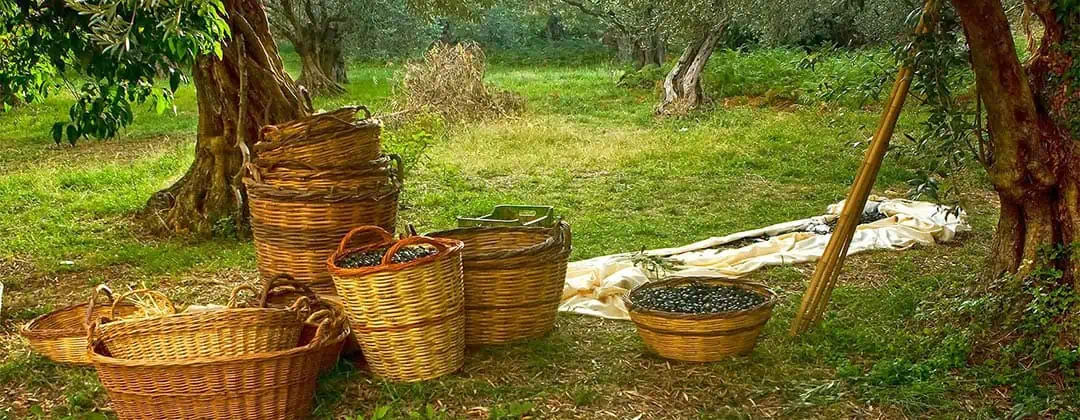
CRITIDA BIO CRETAN OLIVE OIL - Producers of Premium Cretan Culinary Products: Our Food Products are EXPORTED WORLDWIDE to 40+ countries, since 1998 - Join Us!
We are a centuries-long family company (est 1912) in the production of EVOO Olive Oil on the island of CRETE in GREECE. Our Premium Cretan extra virgin olive oil and culinary food products are exported in 40+ countries worldwide to a carefully selected network of partners. CONTACT US, BE OUR NEXT VALUED BUSINESS PARTNER ! for Extra Virgin Olive Oil (EVOO) - Organic (Bio) Extra Virgin Olive Oil (Organic EVOO) - Greek Table Olives - Balsamic Vinegars - Delicatessen, all from CRETE GREECE
Related posts
History of the Olive Tree and Olive Oil
History of the Olive Tree According to scientists, the exact place where the olive tree was found fo
The benefits of Extra Virgin Olive Oil
Extra Virgin Olive Oil: the Benefits on Human Health 1 – Protects Heart’s Health Studies
Olive Oil Ingredients (Chemical Composition of EVOO)
Learn more about the Chemical Characteristics of Olive Oil – Fatty Acids, Trans Fatty Acids,
Frying with olive oil
Is extra virgin olive oil suitable for frying dishes? Frying is one of the few characteristics commo



